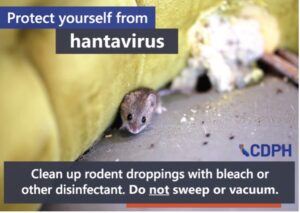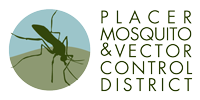
Rodents and their fleas are capable of transmitting a variety of human diseases including plague, hantavirus and salmonella. The District is primarily concerned with community-wide risk of rodent-borne disease like plague, hantavirus or large community-wide infestations.
The District can help to provide advice and guidance and in severe cases, do rodent inspections. We do not conduct rodent baiting or trapping.
For more guidance on rodent control, visit the UC Davis IPM website.
Rodents of Public Health Concern in Placer County

Ground Squirrels and Chipmunks
Tahoe Basin area residents who find dead ground squirrels or chipmunks on your property that do not have obvious signs of trauma, please call (916) 558-1784 to report it. The District partners with California Department of Public Health to monitor for plague.

Deer Mouse (Peromyscus maniculatus)
Sometimes this mouse is called the white-footed mouse. Deer mice are jumpers and runners that receive their name due to their agility. Deer mice prefer forests, grasslands and agricultural crops and they are not normally found within urban and residential areas unless fields, forests or other suitable habitats surround those areas.
Deer mice are vectors of the Sin Nombre virus which causes hantavirus pulmonary syndrome and other serious complications. Deer mice shed the virus in their urine, droppings and saliva. In areas, especially indoors, where these rodents are found, take special precautions to prevent hantavirus transmission like wearing protective goggles and a mask, spraying a disinfectant on areas with droppings, urine or nest materials and wet mopping to avoid sweeping or vacuuming.

Roof Rat (Rattus rattus)
Sometimes this rat is called the black rat. They are slightly smaller than Norway rats. Unlike Norway rats, their tails are longer than their heads and bodies combined. Roof rats are agile climbers and usually live and nest above-ground in shrubs, trees and dense vegetation such as ivy. In buildings, they are most often found in enclosed or elevated spaces such as attics, walls, false ceilings and cabinets. The roof rat has a more limited geographical range than the Norway rat, preferring ocean-influenced, warmer climates. In areas where the roof rat occurs, the Norway rat may also be present.

Norway Rat (Rattus norvegicus)
Sometimes this rat is called the brown or sewer rat. They are stocky burrowing rodents that are larger than roof rats. Their burrows are found along building foundations, beneath rubbish or woodpiles and in moist areas in and around gardens and fields. Nests can be lined with shredded paper, cloth or other fibrous material. When Norway rats invade buildings, they usually remain in the basement or ground floor. Norway rats live throughout the 48 contiguous United States. While generally found at lower elevations, this species can occur wherever people live.

House Mouse (Mus musculus)
House mice are small rodents with relatively large ears and small, black eyes. They weigh about half an ounce and usually are light brownish to gray. An adult is about five to seven inches long including the three to four-inch tail. House mice thrive under a variety of conditions. They are found in and around homes and commercial structures as well as in open fields and on agricultural land. House mice consume and contaminate food meant for humans, pets, livestock or other animals.
Rodent-transmitted Diseases
Hantavirus

Hantavirus is a virus spread through the urine, droppings, or saliva of rodents, like deer mice, which are common in California, especially in the Truckee and Tahoe Basin area. People can become infected by breathing in air contaminated with the virus, especially when cleaning spaces like your shed, garages, or other building structures, where mice have been. Hantavirus can cause mild to severe symptoms, depending on whether it affects the lungs. There is no specific treatment, but early medical care can help.
To prevent hantavirus infection, it’s important to keep rodents out of living spaces by sealing holes, using traps, and storing food in rodent-proof containers. If cleaning areas with rodent signs, avoid sweeping or vacuuming, and use gloves and disinfectant.
Before you start cleaning
- Gather the proper supplies, including rubber or plastic gloves and a disinfectant or bleach solution made from a mixture of household bleach and water.
- Air out the space you will be cleaning for 30 minutes.
While cleaning (wear gloves)
- Spray the contaminated area with the disinfectant or bleach solution until very wet, and let it soak for at least 5 minutes.
- Use paper towels, a sponge, or mop to clean up the contaminated area.
Hantavirus Pulmonary Syndrome (HPS) is a rare but often fatal lung disease caused by the Sin Nombre virus (SNV), which is transmitted to humans by deer mice. HPS was first identified in 1993 in the southwestern U.S. and primarily occurs in the western U.S. due to SNV.
For more information about hantavirus, visit the California Department of Public Health’s hantavirus webpage or the Center for Disease Control’s hantavirus webpage.
Plague
Plague is an ancient disease that has caused many deaths in history, including during the “Black Death.” It’s rare in humans now but still affects rodents in parts of California and the southwestern U.S. People can get plague from flea bites or contact with infected animals. It causes fever and swollen lymph nodes, but antibiotics can treat it if caught early. If untreated, it can be severe or fatal. People in areas with plague should avoid wild rodents and fleas, and domestic cats can also spread it.
For more information about plague, visit the California Department of Public Health Vector-borne Disease plague webpage or the CDC’s plague webpage.






